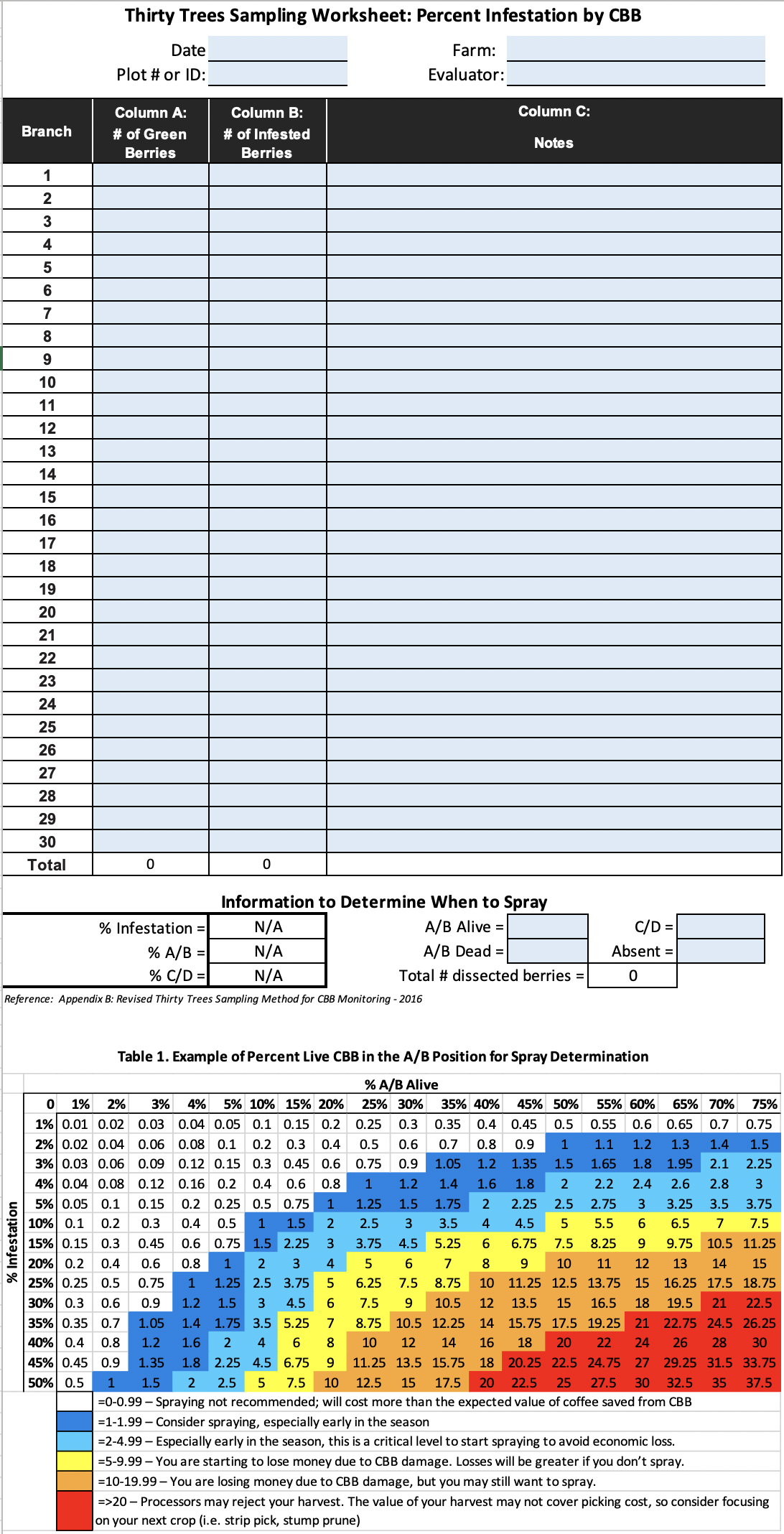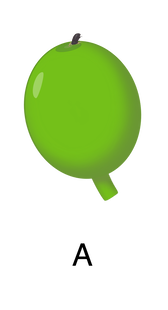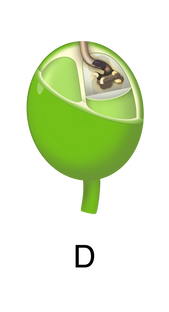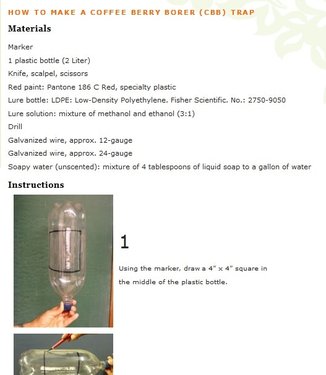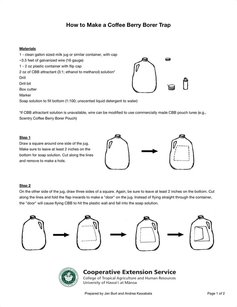Section II: Field Monitoring
The information below, is an excerpt from the "Recommendations for Coffee Berry Borer Integrated Pest Management in Hawai‘i 2020" document. The complete article can be downloaded here.
Use the “Thirty Trees Sampling Method for CBB Monitoring – 2020,” traps, visual monitoring, or a combination of these methods on your farm to help determine the most effective times to manage CBB. Beetle numbers and activity may fluctuate greatly during the course of a season, so sporadic sampling may miss significant CBB movement. Year-round monitoring will lead to a better understanding of your operation and will help you assess beetle activity and make informed decisions on appropriate management actions.
A. Record Keeping
Noting major farm events, such as your first and main flowering; spray dates, times, and rates; harvesting; pruning dates and descriptions; etc. on a calendar or notebook, or in Appendix A for your individual farm(s), is highly recommended. Recordkeeping of all farm activities and major observations makes activities like spraying, fertilizing, sampling, etc. easier to schedule, organize, and accomplish. As a result, you may gain a better understanding of your crop and the distinct dynamics of your farm, your farm-management needs, and the relationship between events on your farm and CBB behavior. It is also recommended that you save the records of each sampling (pages 16 and 17 of Appendix B) for future reference.
- Appendix A: Farm record log sheets for CBB control activities.
B. Monitoring
CBB-monitoring methods were created by Cenicafé [3] and then revised and validated in two studies [21, 22] to more adequately suit the needs of coffee farmers in Hawai‘i and to address questions about the specific sample size per area being sampled (see Appendix B). Individual farmers may need to make further changes based on their particular situation and needs.
1. Why, when, and how do I sample and monitor for CBB?
|
Early detection of CBB and well-timed pesticide sprays will help to reduce infestations before populations ex- plode. Sampling is vital to determining when to start spraying, spray intervals, and locations of “hot spots,” but remember field sanitation is by far the most important CBB-control method.
|
|
Thirty Trees Sampling Worksheet for CBB Monitoring
Click on the photo to the left to download the excel file so you can record and save your sampling data. Formulas are embedded in the worksheet so you don't have to do any calculations. Just do the berry counts and dissections according to the instructions found in Appendix B. Use these percentages for infestation and A/B alive, as well as the colorful table provided on the spreadsheet, to help aid your decision to spray or not. |
[1] Aristizábal, L.F., A.E. Bustillo, and S.P. Arthurs. 2016. Integrated pest management of coffee berry borer: strategies from Latin America that could be useful for coffee farmers in Hawaii. Insects. 7(1): 1–24. DOI:10.3390/insects7010006.
[3] Bustillo A.E., Cardenas M.R., Villalba D., Orozco J., Benavides M.P., and Posada F.J. 1998. Manejo integrado de la broca del café Hypothenemus hampei (Ferrari) en Colombia. Chinchiná, Colombia: Cenicafé. 134 pp.
[21] Pulakkatu-thodi, I., R. Gutierrez-Coarite, and M.G. Wright. 2018. Dispersion and Optimization of Sequential Sampling Plans for Coffee Berry Borer (Coleoptera: Curculionidae) Infestations in Hawaii. Environmental Entomology. 47(5):1306–1313. https://doi.org/10.1093/ee/nvy098.
[22] Pulakkatu-thodi, I., R. Gutierrez, and M.G. Wright. 2017. Comparison of Sampling Intensity to Estimate Infestations of Coffee Berry Borer on Hawaii. Proceedings of the Hawaiian Entomological Society. (2017) 49:11–16. https://scholarspace.manoa.hawaii.edu/bitstream/10125/48120/PHES49_11-16.pdf.
[3] Bustillo A.E., Cardenas M.R., Villalba D., Orozco J., Benavides M.P., and Posada F.J. 1998. Manejo integrado de la broca del café Hypothenemus hampei (Ferrari) en Colombia. Chinchiná, Colombia: Cenicafé. 134 pp.
[21] Pulakkatu-thodi, I., R. Gutierrez-Coarite, and M.G. Wright. 2018. Dispersion and Optimization of Sequential Sampling Plans for Coffee Berry Borer (Coleoptera: Curculionidae) Infestations in Hawaii. Environmental Entomology. 47(5):1306–1313. https://doi.org/10.1093/ee/nvy098.
[22] Pulakkatu-thodi, I., R. Gutierrez, and M.G. Wright. 2017. Comparison of Sampling Intensity to Estimate Infestations of Coffee Berry Borer on Hawaii. Proceedings of the Hawaiian Entomological Society. (2017) 49:11–16. https://scholarspace.manoa.hawaii.edu/bitstream/10125/48120/PHES49_11-16.pdf.
A/B and C/D positions of CBB on the coffee berry, or in the coffee bean, and its vulnerability to spray for control
(drawings below by J. Burt (2019); UH CTAHR)
|
A: CBB has made a hole in the coffee skin (exocarp) but has not drilled far enough into the pulp (mesocarp) to disappear from view. The parchment and bean has not yet been damaged.
Approved Beauveria and contact insecticide sprays can be used to kill CBB in this position. |
B: CBB has made a hole in the coffee skin and pulp, but has not yet damaged the parchment or seed (endosperm) within. The hole will be visible, but not necessarily the beetle itself, unless the berry is dissected.
Approved Beauveria and contact insecticide sprays can be used to kill CBB in this position, but may be less effective than when CBB are in the A position. |
C: CBB has drilled past the coffee skin, pulp and parchment and is now beginning to damage the bean or seed.
In this position, CBB are fairly safe. Approved Beauveria and contact insecticide sprays are less effective than when CBB are in the A and B positions. Harvest and berry removal can be used to kill CBB in the C position. |
D: CBB has entered the bean and caused much damage to the seed (endosperm). A new generation of CBB are developing or have matured to adulthood.
In this position, CBB are very safe from Beauveria and contact insecticides. There will be new immature and adult CBB in the bean(s), so attempting to kill the founding female by spraying is futile. At this point, only harvest or berry removal will kill CBB in the bean. One or both beans may be lost due to CBB damage. |
Videos: Sampling and Monitoring
|
Part I - In the Field
|
Part II - Dissection and Decision
|
Learn how to build your own CBB traps
Contact website management if you require any assistance with the site or information provided.
